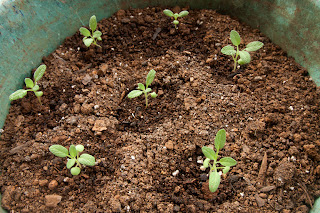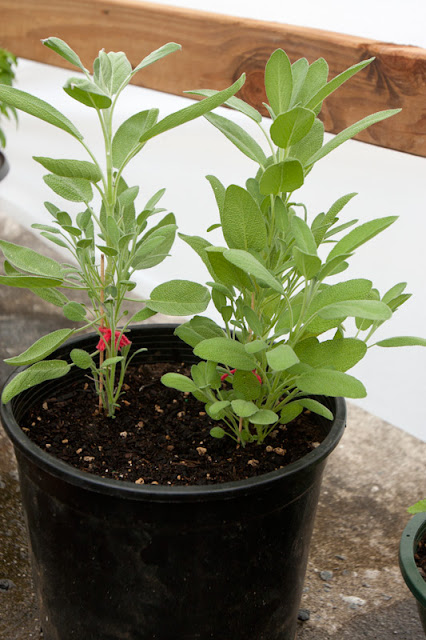An Intro to Sage
MY STATUS: Grown Successfully to HarvestSage is a shrub-like woody-stemmed perennial herb with broad dusty green-gray leaves and a strong aroma. It's often used to flavor poultry. The family of plants consists of hundreds of varieties that are found all over the drier parts of Asia, the Mediterranean, and the Americas. Plants can grow nearly three feet tall. Leaves can be harvested (lightly for the first year) after the plant is about two months old. Usually the flavor of the leaves diminishes after a few years and the plant needs to be replaced.
PARTIAL SUN
Although most gardening guides will tell you that sage needs full sun, those guides weren't written with the tropics in mind. I have found that direct sun on Pohnpei is okay before about 11 AM, but after that it is too strong for young sage plants and causes the leaves to droop. If your plants can't be moved into shade when it gets too hot, one option is to mist them with ice water, but a better strategy is to plant it where it will be in open shade or partial sun. Mine has flourished in such conditions. Once the plant is about 3 months old, it should be able to handle full sun all day.
DRY, WELL-DRAINED SOIL & LITTLE WATER
Like most of the common herbs, sage likes dry, well-drained soil. Adding a little sand to the soil mix will benefit the plant. Once the plant is established, you should only need to water about once every 2-3 weeks. It does great in pots.
PESTS
Few pests bother sage, so you will probably not need to worry about them.
What I Did
DAY 1 - SOWING
I sowed the sage along with the bulk of the other herbs in paper egg cartons with regular garden soil. I used Ferry-Morse Start Smart seeds from Home Depot in Southern California. Soil was kept moist, but not wet and the carton was kept in direct sun whenever possible.DAY 6 - GERMINATION
The seeds began to germinate thickly on the sixth day. They have very different looking cotyledons than the other herbs.
DAY 9 - TRANSPLANTATION
DAY 16
Strangely, the seedlings in the two pots are not growing at the same rate, even though they were in the same germination batch and planted identically. The sage in the larger pot is doing great, while the plants in the small pot are struggling. Beautiful true leaves have fully developed on all plants.DAY 18
Plants in the small pot continue to grow much slower than those in the larger pot. Plants in the large pot are getting their second set of true leaves.DAY 26
DAY 31
I fertilized all plants with a solution of Alaska Fish Emulsion.DAY 50
Sage continues to grow well in general (right). I have fertilized twice more since the first application and the plants have responded positively to the extra nutrients. A couple of plants were not keeping up with the rest, but as I had plenty, I pulled those out. More room for the others.DAY 57
All sage plants have many sets of true leaves now and are about 3 inches tall (below). I've harvested leaves here and there as I needed them--never more than two off a single plant at a time.DAY 73
My sage is a slow-grower. I wish it would hurry up a little, but I guess I can't complain, since perennials are always slower. It certainly is healthy. Some of the plants have gotten a little crowded in their original pots, so I've started transplanting them out. They seem to be more fragile than the basil, but so far I haven't had any issues with transplantation. I gave them a few days to recover before exposing them to sun. The leaves are so fragrant! Love it.DAY 94
My transplants are thriving (below). Clearly the extra room has been great for them. One of the plants is now getting a side shoot from the bottom, which is surprising. I only have one plant that is struggling and I can't figure out why, since it is living in the same conditions as the others. It is tiny in comparison.DAY 101
I've been having some trouble with a couple of the sage plants recently. I suspect I over-watered and some of the roots suffocated. One of the plants turned yellow, lost its scent, and then started wilting. Brown spots started appearing on the leaves. As this plant was in a pot with damp soil, the problem could not have been under-watering. It struggled on a few days, but I finally pulled it up only to find that I was correct: there was evidence of root-rot. Luckily, I have four more plants. Two are in a different container and look healthy. The other two seem to be mildly affected by the same thing as the doomed plant, but I think they will recover. One of them is sending up side-shoots, which are as good as new plants.This is a good time to re-emphasize what I forgot--sage is a desert plant and doesn't need much water. It's best to let the soil dry out completely between watering sessions.
DAY 114
Since I essentially cut down watering to as little as once every 2-3 weeks, the plants have improved. I'm also giving them more sun. The ones in the plastic pot--which were always about half as large as the others--have leaped up and surpassed all others.DAY 140
The sage seems to be enjoying its new home in the garden shelter I built on our roof. It has also liked the sunny weather we've had over the last week. I have only three plants remaining from the initial twelve. This has been a finicky and slow-growing plant, but I think I've got the hang of things now. I can't stress this enough--let your sage go without watering. I'm now watering only once about every 2-3 weeks and the plants look better than they ever have. Remember, this plant grows in the wild on rocky hillsides in the desert.The most recent develop with my three plants has been bottom-shoots. Two of the plants have several quite large shoots coming up from the lower stem. Each shoot looks like a new sage plant, and they are growing much faster than the mother plants did. The two plants that were originally the most stunted are now about a foot tall and have HUGE leaves. What's perplexing is how the plants have flip-flopped in their growth. I planted seedlings in two containers--one large one and one much smaller one. For the longest time, the plants in the smaller container were doing poorly compared to those in the larger container. They were less than half the size. Then plants started dying in my larger container (I now know this was due to over-watering). I started transplanting out the survivors into their own pots. They continued to out-grow the one's in the smaller pot. Suddenly, everything switched. The plants in the small pot shot up, but out tons of side-shoots and became huge in a short period of time, dwarfing those that had once dwarfed them. They're leaves are currently almost as wide as the the other plants leaves are long.




















.jpg)







0 comments:
Post a Comment